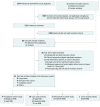Association Between Marijuana Use and Risk of Cancer: A Systematic Review and Meta-analysis
- PMID: 31774524
- PMCID: PMC6902836
- DOI: 10.1001/jamanetworkopen.2019.16318
Association Between Marijuana Use and Risk of Cancer: A Systematic Review and Meta-analysis
Erratum in
-
Error in Table 1.JAMA Netw Open. 2020 Jan 3;3(1):e1921065. doi: 10.1001/jamanetworkopen.2019.21065. JAMA Netw Open. 2020. PMID: 31940033 Free PMC article. No abstract available.
Abstract
Importance: Marijuana use is common and growing in the United States amid a trend toward legalization. Exposure to tobacco smoke is a well-described preventable cause of many cancers; the association of marijuana use with the development of cancer is not clear.
Objective: To assess the association of marijuana use with cancer development.
Data sources: A search of PubMed, Embase, PsycINFO, MEDLINE, and the Cochrane Library was conducted on June 11, 2018, and updated on April 30, 2019. A systematic review and meta-analysis of studies published from January 1, 1973, to April 30, 2019, and references of included studies were performed, with data analyzed from January 2 through October 4, 2019.
Study selection: English-language studies involving adult marijuana users and reporting cancer development. The search strategy contained the following 2 concepts linked together with the AND operator: marijuana OR marihuana OR tetrahydrocannabinol OR cannabinoid OR cannabis; AND cancer OR malignancy OR carcinoma OR tumor OR neoplasm.
Data extraction and synthesis: Two reviewers independently reviewed titles, abstracts, and full-text articles; 3 reviewers independently assessed study characteristics and graded evidence strength by consensus.
Main outcomes and measures: Rates of cancer in marijuana users, with ever use defined as at least 1 joint-year exposure (equivalent to 1 joint per day for 1 year), compared with nonusers. Meta-analysis was conducted if there were at least 2 studies of the same design addressing the same cancer without high risk of bias when heterogeneity was low to moderate for the following 4 cancers: lung, head and neck squamous cell carcinoma, oral squamous cell carcinoma, and testicular germ cell tumor (TGCT), with comparisons expressed as odds ratios (ORs) with 95% CIs.
Results: Twenty-five English-language studies (19 case-control, 5 cohort, and 1 cross-sectional) were included; few studies (n = 2) were at low risk of bias. In pooled analysis of case-control studies, ever use of marijuana was not associated with head and neck squamous cell carcinoma or oral cancer. In pooled analysis of 3 case-control studies, more than 10 years of marijuana use (joint-years not reported) was associated with TGCT (OR, 1.36; 95% CI, 1.03-1.81; P = .03; I2 = 0%) and nonseminoma TGCT (OR, 1.85; 95% CI, 1.10-3.11; P = .04; I2 = 0%). Evaluations of ever use generally found no association with cancers, but exposure levels were low and poorly defined. Findings for lung cancer were mixed, confounded by few marijuana-only smokers, poor exposure assessment, and inadequate adjustment; meta-analysis was not performed for several outcomes.
Conclusions and relevance: Low-strength evidence suggests that smoking marijuana is associated with developing TGCT; its association with other cancers and the consequences of higher levels of use are unclear. Long-term studies in marijuana-only smokers would improve understanding of marijuana's association with lung, oral, and other cancers.
Trial registration: PROSPERO identifier: CRD42018102457.
Conflict of interest statement
Figures



References
-
- Results from the 2017. National Survey on Drug Use and Health: detailed tables. https://www.samhsa.gov/data/sites/default/files/cbhsq-reports/NSDUHDetai.... Accessed October 17, 2019.
-
- National Institutes of Health Prevalence of marijuana use among U.S. adults doubles over past decade [press release]. https://www.nih.gov/news-events/news-releases/prevalence-marijuana-use-a.... Published October 21, 2015. Accessed October 17, 2019.
-
- Hoffmann D, Brunnemann KD, Gori GB, et al. . On the carcinogenicity of marijuana smoke In: Runeckles VC, ed. Recent Advances in Phytochemistry. Boston, MA: Springer-Verlag; 1975:63-81. doi:10.1007/978-1-4684-0823-2_3 - DOI
Publication types
MeSH terms
Grants and funding
LinkOut - more resources
Full Text Sources
Medical
Miscellaneous

